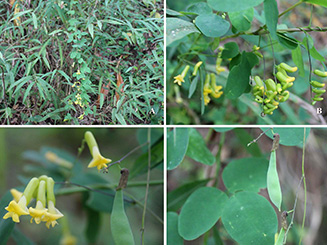The genus Dumasia (Fabaceae) in Thailand
DOI:
https://doi.org/10.20531/tfb.2019.47.1.15Keywords:
Dumasia, Fabaceae, Glycininae, Leguminosae, Phaseoleae, ThailandAbstract
In Thailand two species of Dumasia occur, D. villosa subsp. villosa and D. yunnanensis. They grow in montane and dry evergreen forests, in open or disturbed areas and limestone ridges 550–2,500 meters above sea level, in northern, northeastern, and central Thailand. We present a key to the two Thai Dumasia based on their vegetative, flowering and fruiting characters, and provide nomenclature, descriptions, photographs, illustrations, and information about their distribution and ecology.
Downloads
Download data is not yet available.
References
Craib, W.G. (1928). Florae Siamensis Enumeratio. Vol. 1 part 3. Siam Society, Bangkok.
De Candolle, A.P. (1825). Dumasia DC. Annales des sciences naturelles; comprenant la physiologie animale et végétale, l’anatomie comparée des deux règnes, la zoologie, la botanique, la minéralogue et la géologie. Paris. 4: 96–97.
Ferguson, I.K. & Skvarla, J.J. (1981). The pollen morphology of the subfamily Papilionoideae (Leguminosae). In: R.M. Polhill & P.H. Raven (eds), Advances in Legumes Systematics Part 2, pp. 859–896. Royal Botanic Gardens Kew, UK.
Harvey, W.H. (1894). Dumasia DC. In: W.H. Harvey & O.W. Sonder (eds), Flora Capensis 2, p. 234.
Hodges, Smith & Co., Dublin. Lackey, J.A. (1981). Tribe Phaseoleae. In: R.M. Polhill & P.H. Raven (eds). Advances in
Legumes Systematics Part 1, pp. 301–327. Royal Botanic Gardens Kew, UK.
Pan, B. & Zhu, X.Y. (2010). Taxonomic revision of Dumasia (Fabaceae, Papilionoideae). Annales Botanici Fennici 47: 241–256.
Schrire, B.D. (2005). Tribe Phaseoleae. In: G. Lewis, B. Schrire, B. Mackinder and M. Lock (eds). Legumes of the World, pp. 393–431. Royal Botanic Gardens Kew, UK.
Verdcourt, B. (1979). A manual of New-Guinea legumes. Botany Bulletin No. 11, Office of Forests, Division of Botany, Lae, Papua New Guinea, pp. 488–490.
De Candolle, A.P. (1825). Dumasia DC. Annales des sciences naturelles; comprenant la physiologie animale et végétale, l’anatomie comparée des deux règnes, la zoologie, la botanique, la minéralogue et la géologie. Paris. 4: 96–97.
Ferguson, I.K. & Skvarla, J.J. (1981). The pollen morphology of the subfamily Papilionoideae (Leguminosae). In: R.M. Polhill & P.H. Raven (eds), Advances in Legumes Systematics Part 2, pp. 859–896. Royal Botanic Gardens Kew, UK.
Harvey, W.H. (1894). Dumasia DC. In: W.H. Harvey & O.W. Sonder (eds), Flora Capensis 2, p. 234.
Hodges, Smith & Co., Dublin. Lackey, J.A. (1981). Tribe Phaseoleae. In: R.M. Polhill & P.H. Raven (eds). Advances in
Legumes Systematics Part 1, pp. 301–327. Royal Botanic Gardens Kew, UK.
Pan, B. & Zhu, X.Y. (2010). Taxonomic revision of Dumasia (Fabaceae, Papilionoideae). Annales Botanici Fennici 47: 241–256.
Schrire, B.D. (2005). Tribe Phaseoleae. In: G. Lewis, B. Schrire, B. Mackinder and M. Lock (eds). Legumes of the World, pp. 393–431. Royal Botanic Gardens Kew, UK.
Verdcourt, B. (1979). A manual of New-Guinea legumes. Botany Bulletin No. 11, Office of Forests, Division of Botany, Lae, Papua New Guinea, pp. 488–490.

Downloads
Published
2019-06-14
How to Cite
Meeboonya, R., Ngernsaengsaruay, C., Balslev, H., & Chayamarit, K. (2019). The genus Dumasia (Fabaceae) in Thailand. Thai Forest Bulletin (Botany), 47(1), 113–120. https://doi.org/10.20531/tfb.2019.47.1.15
Issue
Section
Articles

